| Revision as of 05:10, 22 February 2018 editPohranicniStraze (talk | contribs)Extended confirmed users, Pending changes reviewers, Rollbackers105,198 edits Undid revision 826994774 by 169.159.104.65 (talk) remove honorificsTag: Undo← Previous edit | Revision as of 00:25, 3 March 2018 edit undo216.81.94.72 (talk) →ExtractionNext edit → | ||
| Line 127: | Line 127: | ||
| The female pig's natural truffle-seeking, as well as her usual intent to eat the truffle, is due to a compound within the truffle similar to ], the sex ] of boar saliva, to which the sow is keenly attracted. | The female pig's natural truffle-seeking, as well as her usual intent to eat the truffle, is due to a compound within the truffle similar to ], the sex ] of boar saliva, to which the sow is keenly attracted. | ||
| In ], the use of the pig to hunt truffles has been prohibited since 1985 because of damage caused by animals to truffle's ] during the digging that dropped the production rate of the area for some years. | In ], the use of the pig to hunt truffles has been prohibited since 1985 because of damage caused by animals to truffle's ] during the digging that dropped the production rate of the area for some years. In a recent episode of the Bachelor (ABC), truffles were hunted by an Italian citizen, with his dog. The dog found three truffles, and the citizen later scraped some truffles onto the Bachelor's and his date's food. | ||
| == Volatile constituents == | == Volatile constituents == | ||
Revision as of 00:25, 3 March 2018
For other uses, see Truffle (disambiguation).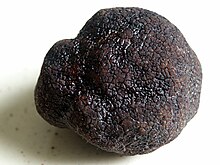
A truffle is the fruiting body of a subterranean Ascomycete fungus, predominantly one of the many species of the genus Tuber. Truffles are ectomycorrhizal fungi and are therefore usually found in close association with tree roots. Spore dispersal is accomplished through fungivores, animals that eat fungi.
Some of the truffle species are highly prized as food. French gourmet Jean Anthelme Brillat-Savarin called truffles "the diamond of the kitchen". Edible truffles are held in high esteem in French, Croatian, Georgian, Bulgarian, Greek, Italian, Middle Eastern, and Spanish cuisine, as well as in international Error: {{Lang}}: text has italic markup (help).
History
Antiquity
The first mention of truffles appears in the inscriptions of the neo-Sumerians regarding their Amorite enemy's eating habits (Third Dynasty of Ur, 20th century BC) and later in writings of Theophrastus in the fourth century BC. In classical times, their origins were a mystery that challenged many; Plutarch and others thought them to be the result of lightning, warmth and water in the soil, while Juvenal thought thunder and rain to be instrumental in their origin. Cicero deemed them children of the earth, while Dioscorides thought they were tuberous roots.
Rome and Thracia in the Classical period produced three kinds of truffles: the Error: {{Lang}}: text has italic markup (help), the Error: {{Lang}}: text has italic markup (help) and the Error: {{Lang}}: text has italic markup (help). The Romans, however, did not use these and instead used a variety of fungus called Terfez, also sometimes called a "desert truffle." Terfez used in Rome came from Lesbos, Carthage, and especially Libya, where the coastal climate was less dry in ancient times. Their substance is pale, tinged with rose. Unlike truffles, terfez have little inherent flavor. The Romans used the terfez as a carrier of flavor, because the terfez tend to absorb surrounding flavors. Indeed, Ancient Roman cuisine used many spices and flavorings, and terfez were perfect in that context.
Middle Ages
Truffles were rarely used during the Middle Ages. Truffle hunting is mentioned by Bartolomeo Platina, the papal historian, in 1481, when he recorded that the sows of Notza were without equal in hunting truffles, but they should be muzzled to prevent them from eating the prize.
According to a hadith narrated by Saeed bin Zaid, Muhammad said that truffles are like manna and that water from truffles "heals eye diseases".
Renaissance and modern times
During the Renaissance, truffles regained popularity in Europe and were honoured at the court of King Francis I of France. However, it was not until the 17th century that Western (and in particular French) cuisine abandoned "heavy" oriental spices, and rediscovered the natural flavour of foodstuffs. Truffles were very popular in Parisian markets in the 1780s. They were imported seasonally from truffle grounds, where peasants had long enjoyed their secret. Brillat-Savarin (1825) noted characteristically that they were so expensive they appeared only at the dinner tables of great nobles and kept women. A great delicacy was a truffled turkey.
Cultivation

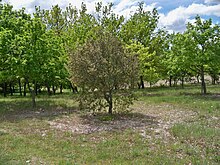
Truffles long eluded techniques of domestication, as Jean-Anthelme Brillat-Savarin (1825) noted:
The most learned men have sought to ascertain the secret, and fancied they discovered the seed. Their promises, however, were vain, and no planting was ever followed by a harvest. This perhaps is all right, for as one of the great values of truffles is their dearness, perhaps they would be less highly esteemed if they were cheaper.
However, truffles can be cultivated. As early as 1808, there were successful attempts to cultivate truffles, known in French as Error: {{Lang}}: text has italic markup (help). People had long observed that truffles were growing among the roots of certain trees, and in 1808, Joseph Talon, from Apt (département of Vaucluse) in southern France, had the idea of transplanting some seedlings that he had collected at the foot of oak trees known to host truffles in their root system.
For discovering how to cultivate truffles, some sources now give priority to Pierre II Mauléon (1744–1831) of Loudun (in the Vienne department), who began to cultivate truffles around 1790. Mauléon saw an "obvious symbiosis" between the oak tree, the rocky soil and the truffle, and attempted to reproduce such an environment by taking acorns from trees known to have produced truffles, and sowing them in chalky soil. His experiment was successful, with truffles being found in the soil around the newly grown oak trees years later. In 1847, Auguste Rousseau of Carpentras (in Vaucluse) planted 7 hectares (17 acres) of oak trees (again from acorns found on the soil around truffle-producing oak trees), and he subsequently obtained large harvests of truffles. He received a prize at the 1855 World's Fair in Paris.

These successful attempts were met with enthusiasm in southern France, which possessed the sweet limestone soils and dry, hot weather that truffles need to grow. In the late 19th century, an epidemic of phylloxera destroyed many of the vineyards in southern France. Another epidemic killed most of the silkworms there, too, making the fields of mulberry trees useless. Thus, large tracts of land were set free for the cultivation of truffles. Thousands of truffle-producing trees were planted, and production reached peaks of hundreds of tonnes at the end of the 19th century. In 1890, there were 75,000 hectares (190,000 acres) of truffle-producing trees.
In the 20th century, however, with the growing industrialization of France and the subsequent rural exodus, many of these truffle fields ( Error: {{Lang}}: text has italic markup (help) or Error: {{Lang}}: text has italic markup (help)) returned to wilderness. The First World War also dealt a serious blow to the French countryside, killing 20% or more of the male working force. As a consequence, newly acquired techniques of Error: {{Lang}}: text has italic markup (help) were lost. Also, between the two world wars, the truffle groves planted in the 19th century stopped being productive. (The average life cycle of a truffle-producing tree is 30 years.) Consequently, after 1945, the production of truffles plummeted, and the prices have risen dramatically. In 1900, truffles were used by most people, and on many occasions. Today, they are a rare delicacy reserved for the rich, or used on very special occasions.
In the last 30 years, new attempts for mass production of truffles have been started. Eighty percent of the truffles now produced in France come from specially planted truffle groves. Nonetheless, production has yet to recover its 1900s peaks. Local farmers are sometimes opposed to a return of mass production, which would possibly decrease the price of truffles (though it is commonly stated that demand is 10 times higher than supply). In exchange there are heavy investments in cultivated plantations under way in many parts of the world. Thanks to controlled irrigation, regular and resilient production is indeed possible. There are now truffle-growing areas in the United Kingdom, United States, Spain, Sweden, New Zealand, Australia, Chile and South Africa.
A critical phase of the cultivation is the quality control of the mycorrhizal plants. It takes between 7 and 10 years for the truffles to develop their mycorrhizal network, and only after that the host-plants come into production. Both a complete soil analysis to avoid contamination by other dominant fungus and a very strict control of the formation of mycorrhizae are necessary to ensure the success of a plantation. Total investment per hectare for an irrigated and barrier-sealed plantation (against wild boars) can cost up to €10,000. Considering the level of initial investment and the maturity delay, farmers who have not taken care of both soil conditions and seedling conditions are at high risk of failure.
In New Zealand and Australia
The first black truffles ( Error: {{Lang}}: text has italic markup (help)) to be produced in the Southern Hemisphere were harvested in Gisborne, New Zealand, in 1993.
In 1999, the first Australian truffles were harvested in Tasmania, the result of eight years of work. Trees were inoculated with the truffle fungus in the hope of creating a local truffle industry. Their success and the value of the resulting truffles has encouraged a small industry to develop. A Western Australian venture, The Truffle and Wine Company, had its first harvest in 2004, and in 2005 they unearthed a 1-kg (2.2-lb) truffle. In 2008, an estimated 600 kilograms (1,300 lb) of truffles were removed from the rich ground of Manjimup. Each year, the company has expanded its production, moving into the colder regions of Victoria and New South Wales.
In June 2010, Tasmanian growers harvested Australia's largest truffle from their property at Myrtle Bank, near Launceston. It weighed in at 1.084 kilograms (2 lb 6.2 oz) and was valued at about A$1,500 per kg.
New Zealand's first burgundy truffle was found in July 2012 at a Waipara truffle farm. It weighed 330 g and was found by the farm owner's beagle.
Etymology
The origin of the word truffle appears to be the Latin term Error: {{Lang}}: text has italic markup (help), meaning "swelling" or "lump", which became tufer- and gave rise to the various European terms: Croatian Error: {{Lang}}: text has italic markup (help), Danish trøffel, Dutch Error: {{Lang}}: text has italic markup (help), English truffle, French Error: {{Lang}}: text has italic markup (help), German Error: {{Lang}}: text has italic markup (help), Italian Error: {{Lang}}: text has italic markup (help), Polish Error: {{Lang}}: text has italic markup (help), Romanian Error: {{Lang}}: text has italic markup (help), Spanish Error: {{Lang}}: text has italic markup (help), and Swedish Error: {{Lang}}: text has italic markup (help).
The German word Error: {{Lang}}: text has italic markup (help) ("potato") is derived from the Italian term for truffle because of superficial similarities. In Portuguese, the words Error: {{Lang}}: text has italic markup (help) and Error: {{Lang}}: text has italic markup (help) are synonyms, the latter closer to the Latin term.
Biology
The mycelia of truffles form symbiotic, mycorrhizal relationships with the roots of several tree species including beech, birch, hazel, hornbeam, oak, pine, and poplar. They prefer argillaceous or calcareous soils that are well drained and neutral or alkaline. Truffles fruit throughout the year, depending on the species, and can be found buried between the leaf litter and the soil.
Phylogeny
The phylogeny and biogeography of truffles was investigated in 2008 using internal transcribed spacers (ITS) of nuclear DNA with five major clades (Aestivum, Excavatum, Rufum, Melanosporum and Puberulum); this was later improved and expanded in 2010 to nine major clades using large subunits (LSU) of mitochondrial DNA. The Magnatum and Macrosporum clades were distinguished as distinct from the Aestivum clade. The Gibbosum clade was resolved as distinct from all other clades, and the Spinoreticulatum clade was separated from the Rufum clade.
Species
Black truffle
Main article: Tuber melanosporum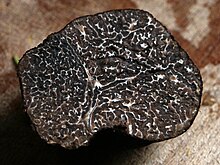
The black truffle or black Périgord truffle (Tuber melanosporum), the second-most commercially valuable species, is named after the Périgord region in France and grows with oak and hazelnut trees. Black truffles are harvested in late autumn and winter. The genome sequence of the black truffle was published in March 2010.
Summer or burgundy truffle
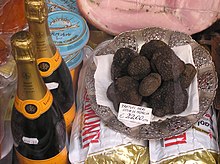
The black summer truffle (Tuber aestivum) is found across Europe and is prized for its culinary value. Burgundy truffles (designated Tuber uncinatum, but the same species) are harvested in autumn until December and have aromatic flesh of a darker colour.
White truffle
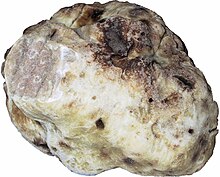
The white truffle or trifola d'Alba Madonna ("Truffle of the White Madonna" in Italian) (Tuber magnatum) is found mainly in the Langhe and Montferrat areas of the Piedmont region in northern Italy and, most famously, in the countryside around the cities of Alba and Asti. Acqualagna, in the northern part of the Marche near Urbino, is another center for the production and commercialization of white truffles, and its annual festival is one of the most important in Italy.
White truffles can also be found in Molise, Abruzzo and in the hills around San Miniato, in Tuscany. It is also found on the Istria peninsula, in Croatia in the Motovun forest along the Mirna river, and in Slovenia along the Dragonja and Rizana river, as well as in the Drome area in France.
Growing symbiotically with oak, hazel, poplar and beech and fruiting in autumn, they can reach 12 cm (5 in) diameter and 500 g, though are usually much smaller. The flesh is pale cream or brown with white marbling. Italian white truffles are very highly esteemed and are the most valuable on the market: The white truffle market in Alba is busiest in the months of October and November when the Fiera del Tartufo (truffle fair) takes place. In 2001, the Tuber magnatum truffles sold for between $1000–$2200 per pound ($2000–$4500 per kg); as of December 2009 they were being sold at $14,203.50 per kilogram.
In 1999, one of the largest truffles in the world was found near Buje, Croatia. The truffle weighed 1.31 kilograms (2 lb 14 oz) and has entered the Guinness Book of Records.
The record price paid for a single white truffle was set in December 2007, when Macau casino owner Stanley Ho paid $330,000 (£165,000) for a specimen weighing 1.5 kilograms (3.3 lb). One of the largest truffles found in decades, it was unearthed near Pisa, Italy, and sold at an auction held simultaneously in Macau, Hong Kong, and Florence. This record was then matched on November 27, 2010, when Ho again paid $330,000 for a pair of white truffles, including one weighing nearly a kilogram.
In December 2014, a white truffle weighing 4.16 pounds or 1.89 kilos was unearthed in the Umbrian region of Italy. It was auctioned at Sotheby's in New York. While some had expected it to sell for $1 million, it was sold for $61,000 to a Taiwanese buyer.
A variety of white truffle (Tuber magnatum pico) is found in other parts of northern and central Italy, but is not as aromatic as those from Piedmont.
Whitish truffle
The "whitish truffle" (Tuber borchii) is a similar species found in Tuscany, Abruzzo, Romagna, Umbria, the Marche and Molise. It is not as aromatic as those from Piedmont, although those from Città di Castello come quite close.
Other species
A less common truffle is "garlic truffle" (Tuber macrosporum).
In the U.S. Pacific Northwest, several species of truffle are harvested both recreationally and commercially, most notably, the Leucangium carthusianum, "Oregon Black truffle", Tuber gibbosum, "Oregon spring white", and Tuber oregonense, the "Oregon winter white truffle". Kalapooya Brunea, the "Oregon Brown Truffle", has also been commercially harvested and is of culinary note.
The pecan truffle (Tuber lyonii) syn. texense is found in the Southern United States, usually associated with pecan trees. Chefs who have experimented with them agree "they are very good and have potential as a food commodity". Although pecan farmers used to find them along with pecans and discard them, considering them a nuisance, they sell for about $160 a pound and have been used in some gourmet restaurants.
Truffle-like species
The term "truffle" has been applied to several other genera of similar underground fungi. The genera Terfezia and Tirmania of the family Terfeziaceae are known as the "desert truffles" of Africa and the Middle East. "Hart's truffle" is a name for Elaphomycetaceae. Pisolithus tinctorius, which was historically eaten in parts of Germany, is sometimes called "Bohemian truffle".
Extraction
See also: Truffle hog| This section does not cite any sources. Please help improve this section by adding citations to reliable sources. Unsourced material may be challenged and removed. (December 2017) (Learn how and when to remove this message) |


| Truffle dog | Truffle hog |
|---|---|
| Keen sense of smell | Keen sense of smell |
| Must be trained | Innate ability to sniff out truffles |
| Easier to control | Tendency to eat truffles once found |
The female pig's natural truffle-seeking, as well as her usual intent to eat the truffle, is due to a compound within the truffle similar to androstenol, the sex pheromone of boar saliva, to which the sow is keenly attracted.
In Italy, the use of the pig to hunt truffles has been prohibited since 1985 because of damage caused by animals to truffle's mycelia during the digging that dropped the production rate of the area for some years. In a recent episode of the Bachelor (ABC), truffles were hunted by an Italian citizen, with his dog. The dog found three truffles, and the citizen later scraped some truffles onto the Bachelor's and his date's food.
Volatile constituents
| External videos | |
|---|---|
The volatile constituents responsible for the natural aroma of truffles are released by the mycelia, fruiting body or derive from truffle-associated microbes. The chemical ecology of truffle volatiles is complex, interacting with plants, insects and mammals, which contribute to spore dispersal. Depending on the truffle species, life cycle or location, these are most notably:
- Sulfur volatiles, which occur in all truffle species, such as dimethyl mono- (DMS), di- (DMDS) and tri- (DMTS) sulfides, as well as 2-methyl-4,5-dihydrothiophene, characteristic of the white truffle T. borchii and bis(methylthio)methane occurring in all species but mostly characteristic of the white truffle T. magnatum. Some of the very aromatic white truffles are notably pungent, even irritating the eye when cut or sliced.
- Metabolites of non-sulfur amino acid constituents (simple and branched chain hydrocarbons) such as ethylene (produced by mycelia of white truffles affecting root architecture of host tree), as well as 2-methylbutanal, 2-methylpropanal and 2-phenylethanol (also common in baker’s yeast).
- Fatty acid-derived volatiles (C8-alcohols and aldehydes with a characteristic fungal odor, such as 1-octen-3-ol and 2-octenal). The former is derived from linoleic acid, and produced by mature white truffle T. borchii.
A number of truffle species and varieties are differentiated based on their relative contents or absence of sulfides, ethers or alcohols, respectively. The sweaty-musky aroma of truffles is similar to that of the pheromone androstenol that also occurs in humans. As of 2010, the volatile profiles of seven black and six white truffle species have been studied.
Culinary use
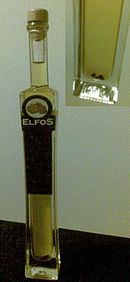
Because of their high price and their pungent aroma, truffles are used sparingly. Supplies can be found commercially as unadulterated fresh produce or preserved, typically in a light brine.
White truffles are generally served raw, and shaved over steaming buttered pasta, salads, or fried eggs. White or black paper-thin truffle slices may be inserted into meats, under the skins of roasted fowl, in foie gras preparations, in pâtés, or in stuffings. Some speciality cheeses contain truffles, as well.
The flavor of black truffles is far less pungent and more refined than that of white truffles. Their strong flavor is often described as syrupy sweet. Black truffles also are used for producing truffle salt and truffle honey.
While in the past chefs used to peel truffles, in modern times, most restaurants brush the truffle carefully and shave it or dice it with the skin on so as to make the most of this valuable ingredient. A few restaurants in Switzerland still stamp out circular discs of truffle flesh and use the skins for sauces.
Truffle oil
Main article: Truffle oilTruffle oil is used as a lower-cost and convenient substitute for truffles, to provide flavoring, or to enhance the flavor and aroma of truffles in cooking. Most "truffle oil", however, does not contain any truffles. The vast majority is olive oil which has been artificially flavoured using a synthetic agent such as 2,4-dithiapentane.
Truffle vodka
Main article: Truffle vodkaThe bulk of truffle oil on the market is made with a synthetic ingredient, as are many other truffle products. However, alcohol can be used to carry the truffle flavour without the need for synthetic flavourings. The first truffle vodka, Black Moth Vodka, is a natural vodka infused with black Périgord truffles (Tuber melanosporum). Although primarily used as a spirit in its own right and mixed in a range of cocktails, truffle vodka is also used by various chefs to flavour dishes by evaporating the alcohol through cooking whilst retaining the truffle aroma.
See also
References
- "Spore release and dispersal". Australian National Botanic Gardens. Retrieved 5 December 2016.
- ^ Brillat-Savarin, Jean Anthelme (1838) . Physiologie du goût. Paris: Charpentier. English translation Archived 2008-07-06 at the Wayback Machine
- "Truffles". Retrieved 2017-01-06.
- Chiera, E. (1934), "Nos. 58 and 112", Sumerian Epics and Myths, Chicago
{{citation}}: CS1 maint: location missing publisher (link) - ^ Ramsbottom J (1953). Mushrooms & Toadstools. Collins.
- Benjamin, D. R. (1995), "Historical uses of truffles", Mushrooms: Poisons and Panaceas — A Handbook for Naturalists, Mycologists and Physicians, New York: WH Freeman and Company, pp. 48–50, ISBN 0716726009
- Sahih al-Bukhari, volume 7, number 609.
- Ian R. Hall and Alessandra Zambonelli, "Chapter 1: Laying the Foundations" in: Alessandra Zambonelli and Gregory M Bonito, ed.s, Edible Ectomycorrhizal Mushrooms: Current Knowledge and Future Prospects (Berlin & Heidelberg, Germany: Springer Verlag, 2012), § 1.2 Cultivation of Truffles: pp. 4-6.
- See: Thérèse Dereix de Laplane (2010) "Des truffes sauvages aux truffes cultivées en Loudunais" (From wild truffles to cultivated truffles in the area of Loudun), Mémoires de l’Académie des Sciences, Arts et Belles-Lettres de Touraine, 23 : 215–241. Available on-line at: Academy of Touraine From pp. 224–225: " … le paysan, a alors l'idée, vers 1790 — puisqu'il y a symbiose évidente entre le chêne, les galluches et la truffe — de provoquer la formation de truffières, en reproduisant leur environnement naturel par des semis de glands dans ses "terres galluches". Avec "les glands venus sur les chênes donnant les truffes, des semis furent faits dans les terrains calcaires voisins" … " ( … the farmer then had the idea, around 1790 — because there is an obvious symbiosis between the oak tree, the rocky soil, and truffles — of inducing the formation of truffle patches, by reproducing their natural environment by sowing acorns in his rocky soils. With "the acorns came from the oak trees producing truffles, sowings were made in the neighboring chalky plots" … )
- "Culture de la truffe à Loudun et à Richelieu," Annales de la Société d'Agriculture Sciences, Arts, et Belles-lettres du Départment d'Indre-et-Loire, 10th series, 48 : 300–302 (1869); see p. 300.
- Rousseau, "Truffes obtenues par la culture de chênes verts" (Truffles obtained by the cultivation of green oaks) in: Exposition universelle de 1855 : Rapports du jury mixte international, volume 1 (Paris, France: Imprimerie Impériale, 1856), pp. 173-174.
- Bungten, ulf; Egli, Simon; Schneider, Loic; Von Arx, Georg; Rigling, Andreas; Camarero, Julio; Sangüesa, Gabriel; Fischer, Christine; Oliach, Daniel; Bonet, Jose-Antonio; Colinas, Carlos; Tegel, Willy; Ruiz, Jose; Martinez, Fernando (2015). "Long-term irrigation effects on Spanish holm oak growth and its black truffle symbiont". Agriculture, Ecosystems and Environment. 202: 148–159. doi:10.1016/j.agee.2014.12.016.
- Olivera, Antoni; Fischer, Christine; Bonet, Jose-Antonio; Martinez de Aragon, Juan; Oliach, Daniel; Colinas, Carlos (2011). "Weed management and irrigation are key treatments in emerging black truffle (Tuber melanosporum) cultivation". New Forests. 42 (2): 227–239. doi:10.1007/s11056-011-9249-9.
- Oliach, Daniel; Muxi, Pere (2012). "Estudi tècnic i econòmic del cultiu de la tòfona (in catalan)" (PDF). Silvicultura. 66: 8–10.
- "Truffles in New Zealand". Southern_truffles.co.nz. Retrieved 2012-07-19.
- Zambonelli, Alessandra; Bonito, Gregory M, eds. (2013). Edible Ectomycorrhizal Mushrooms: Current Knowledge and Future Prospects. Germany: Springer. p. 193. ISBN 978-3-64233822-9. Retrieved 22 Mar 2014.
- "Northeast growers break record with 1084g truffle find". The Examiner. 27 June 2010.
- Australia's ABC Radio, Local Radio network, "Australia All Over" program, 27 June 2010
- "Beagle digs up a New Zealand first". stuff.co.nz. Retrieved 2012-07-26.
- Simpson J., Weiner E. (Editor) (1989). Oxford English Dictionary (2nd ed.). Clarendon Press. ISBN 0-19-861186-2.
{{cite book}}:|author=has generic name (help) - "'finds' registered at Royal Botannical Gardens, Kew". Truffle UK Ltd. Retrieved 2008-05-17.
-
"Non-cultivated Edible Fleshy Fungi". Retrieved 2008-05-17.
...it has been known for more than a century that truffles were mycorrhizal on various trees such as oak, beech, birch, hazels, and a few others
- Jaillard, B; Barry-Etienne, D; Colinas, C; de Miguel, AM; Genola, L; Libre, A; Oliach, D; Saenz, W; Saez, M; Salducci, X; Souche, G; Sourzat, P; Villeneuve, M (2014). "Alkalinity and structure of soils determine the truffle production in the Pyrenean Regions" (PDF). Forest Systems. 23 (2): 364–377. doi:10.5424/fs/2014232-04933.
- Karen Hansen (Spring 2006). K. Griffith (ed.). "Basidiomycota truffles: Cup fungi go underground" (PDF). Newsletter of the FRIENDS of the FARLOW. Harvard University. Archived from the original (PDF) on 2008-11-21. Retrieved 2008-05-17.
Generally, truffles seems to prefer. warm, fairly dry climates and calcareous soils
{{cite web}}: Unknown parameter|deadurl=ignored (|url-status=suggested) (help) - "Mushroom Production". Mycology - Uses of Fungi. University of Sydney. June 2004. Archived from the original on 2008-05-01. Retrieved 2008-05-17.
The soil of the truffiere tends to be alkaline, calcareous, and well drained.
- Jeandroz, S.; Murat, C.; Wang, Y.; Bonfante, P.; Le Tacon, F. (2008). "Molecular phylogeny and historical biogeography of the genus Tuber, the true truffles". Journal of Biogeography. 35 (5): 815–829. doi:10.1111/j.1365-2699.2007.01851.x.
- Bonito GM, Gryganskyi AP, Trappe JM, Vilgalys R (2010). "A global meta-analysis of Tuber ITS rDNA sequences: species diversity, host associations and long-distance dispersal". PLoS ONE. 8: e52765. doi:10.1371/journal.pone.0052765. PMC 3534693. PMID 23300990.
{{cite journal}}: CS1 maint: unflagged free DOI (link) - ^ Carluccio A (2003). The Complete Mushroom Book. Quadrille. ISBN 1-84400-040-0.
- Martin, Francis; Kohler, Annegret; Murat, Claude; et al. (2010), "Périgord black truffle genome uncovers evolutionary origins and mechanisms of symbiosis", Nature, 464 (7291): 1033–8, doi:10.1038/nature08867, PMID 20348908
- "White truffles from Alba". Lifeinitaly.com. Retrieved 2012-06-16.
- "Wine and Truffles Adventure - Piemonte". Savoryadventures.com. Retrieved 2012-06-16.
- "Acqualagna Truffle Town".
- Čeština. "Gastro.croatia.hr". Gastro.croatia.hr. Retrieved 2012-06-16.
- "istrias gold truffles of the slovenian istria are the best in the world". Retrieved 2013-10-16.
- "Education & Networking | National Restaurant Association | National Restaurant Association". Restaurant.org. Retrieved 2012-06-16.
- "Largest truffle". Guinnessworldrecords.com. 1999-11-02. Retrieved 2012-06-16.
- "Giant truffle sets record price". BBC News. 2007-12-02. Retrieved 2007-12-02.
- "World's Largest White Truffle - Sotheby's". Retrieved 2 January 2016.
- Daniela Galarza (2 December 2014). "World's Largest White Truffle Unearthed in Italy". Eater. Retrieved 2 January 2016.
- Nicola Twilley (8 December 2014). "The World's Largest Truffle Goes to Auction". The New Yorker. Retrieved 2 January 2016.
- Fred K. Butters. "A Minnesota Species of Tuber". Botanical Gazette. 35 (6): 427–431. doi:10.1086/328364. JSTOR 2556357.
- J.M. Trappe, A.M. Jumpponen; E. Cázares (1996). "NATS truffle and truffle-like fungi 5: Tuber lyonii (=T. texense), with a key to the spiny-spored Tuber species groups". Mycotaxon. 60: 365–372.
{{cite journal}}: Unknown parameter|lastauthoramp=ignored (|name-list-style=suggested) (help) - Tim Brenneman. "Pecan Truffles". Retrieved 2010-06-03.
- Smith, M.E.; et al. (2012). "Pecan Truffles ( Tuber lyonii ) What We Know and What We Need to Know". Georgia Pecan Magazine (Spring 2012): 52–58.
{{cite journal}}:|access-date=requires|url=(help); Explicit use of et al. in:|first1=(help) - Delectations. Truffle Aroma. Retrieved December 19, 2015.
- Splivallo, R; et al. (2010). "Truffle Volatiles: from chemical ecology to aroma biosynthesis". New Phytologist. 198 (3): 688–699. doi:10.1111/j.1469-8137.2010.03523.x.
{{cite journal}}: Explicit use of et al. in:|last2=(help) - "Truffles: The Most Expensive Food in the World". Retrieved 2017-01-06.
- ^ Daniel Patterson (16 May 2007). "Hocus-Pocus, and a Beaker of Truffles". New York Times. Retrieved 2008-05-17.
Most commercial truffle oils are concocted by mixing olive oil with one or more compounds like 2,4-dithiapentane
- "Truffle vodka article". Mycorrhizalsystems.com. 2010-04-21. Retrieved 2012-06-16.
Bibliography
- Truffle Farming Today, a Comprehensive World Guide. 2015. ISBN 978-84-617-1307-3.
{{cite book}}: Unknown parameter|authors=ignored (help) - Trappe, Matt; Evans, Frank; Trappe, James M. (2007). Field Guide to North American Truffles: Hunting, Identifying, and Enjoying the World's Most Prized Fungi. Natural History Series. Ten Speed Press. ISBN 9781580088626.
{{cite book}}: Check|first3=value (help)
- Nowak, Zachary (2015). Truffle: A Global History. The Edible Series. Reaktion. ISBN 978-1780234366.